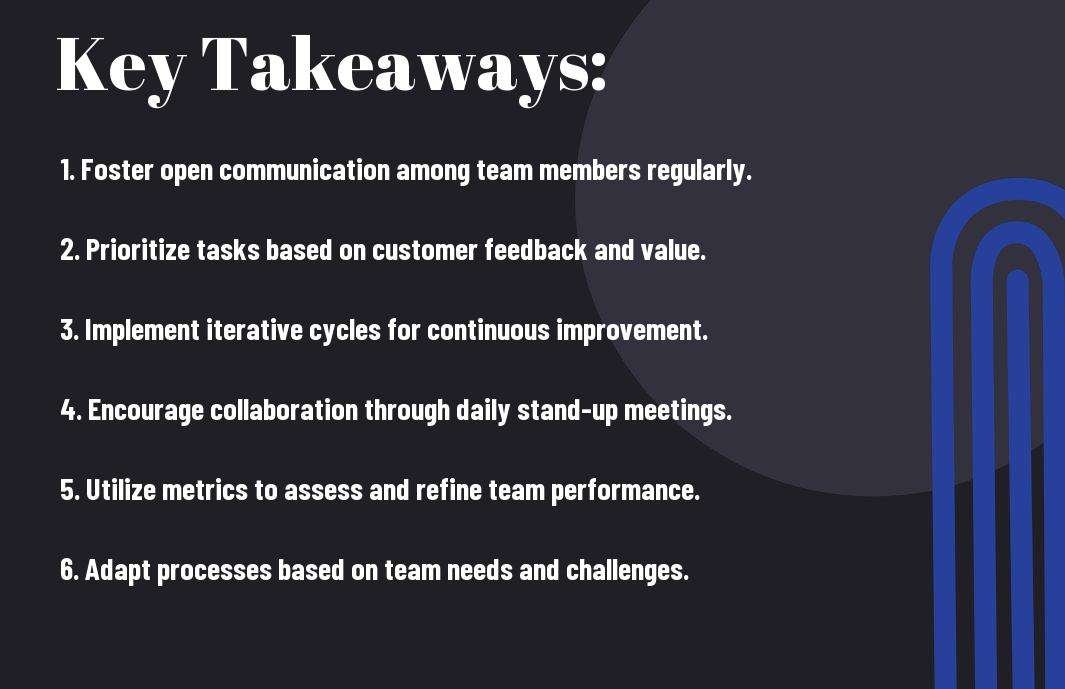Most professionals seek to improve their product development processes, but achieving higher efficiency often requires adopting effective methods. In this post, I will share five crucial steps that can transform your team’s workflow and increase productivity. By implementing these best practices, you’ll be able to navigate challenges more effectively and foster a culture of continuous improvement. If you’re ready to elevate your team’s performance and deliver exceptional results, keep reading to unlock your product development potential.
Key Takeaways:
- Collaboration: Foster a culture of open communication and teamwork within the product development team to enhance productivity and innovation.
- Iterative Processes: Implement short development cycles that allow for quick feedback and adjustments, ensuring that the team remains aligned with project goals.
- Continuous Improvement: Encourage regular reflection and adaptation of practices to optimize workflows and address any obstacles to efficiency.

Understanding Agile Methodology
Agile methodology is a dynamic approach to project management that facilitates flexibility and responsiveness to change during the product development lifecycle. By breaking projects into manageable units known as sprints, it allows teams to deliver value incrementally, ensuring that customer feedback is integrated throughout the process. This focus on collaboration and iterative progress empowers teams to navigate complexities effectively, aligning closely with customer needs.
Key Principles of Agile
After studying the Agile framework, I’ve identified its key principles: prioritizing customer satisfaction through early and continuous delivery, welcoming changing requirements even late in the process, and fostering close collaboration among team members. These principles ensure that you are adapting to user feedback and evolving market demands, ultimately leading to better product outcomes.
Benefits of Agile for Product Development
Between improved collaboration and increased adaptability, Agile offers numerous benefits for product development teams. It enhances communication, encourages innovation, and leads to faster delivery of high-quality products tailored to users’ needs.
Agile provides a stellar framework that boosts your product development team’s performance. By embracing iterative cycles and regular feedback, you foster a collaborative environment that encourages innovation and quick adaptations to market changes. With Agile, you can deliver high-quality products swiftly while continuously incorporating customer insights. This not only enhances your team’s efficiency but also increases customer satisfaction, aligning your development efforts closely with real user needs.
Step 1: Embrace Cross-Functional Teams
You can greatly enhance your product development efficiency by embracing cross-functional teams. These teams bring together diverse skill sets, allowing for quicker decision-making and innovation. When team members from different backgrounds collaborate, they can tackle challenges more effectively and create higher-quality products.
Defining Team Roles
Along with cross-functionality, it’s important to clearly define team roles. Each member should understand their responsibilities and how they contribute to the team’s objectives. This clarity not only minimizes confusion but also maximizes accountability and efficiency within the team.
Fostering Collaboration and Communication
Between team members, fostering a culture of open communication and collaboration is vital. This can be achieved through regular meetings, collaborative tools, and team-building activities that encourage sharing ideas and feedback. Such an environment propels your team’s performance.
For instance, when I organized weekly stand-up meetings, the team members began to share updates and discuss roadblocks more openly. This initial step led to improved participation in our project discussions. Effective communication ensured that team members felt comfortable voicing concerns and sharing insights, paving the way for a more united team effort. The result was a noticeable increase in our productivity levels, addressing issues more quickly, and achieving milestones faster.
Step 2: Implement Regular Feedback Loops
To enhance your product development team’s efficacy, implementing regular feedback loops is paramount. By fostering an environment where feedback is continuously sought and provided, teams can quickly identify and address pain points, ensuring that they are always aligned with customer needs and expectations. This practice not only promotes adaptability but also boosts team morale, as members feel their contributions are valued and recognized.
Importance of Iteration
Beside ensuring you quickly pivot when necessary, iteration allows you to progressively refine your product. Each cycle of feedback can reveal insights that enhance product features or user experiences, ultimately leading to a more refined final product that resonates with your target market.
Tools for Gathering Feedback
Regular user feedback is crucial for successful agile development, and various tools exist to facilitate this process. Surveys, user interviews, and analytics platforms like Hotjar or Google Analytics can provide valuable insights into user behavior and preferences. Additionally, utilizing project management tools such as Jira or Trello allows team members to submit feedback directly related to specific tasks or features, streamlining communication and enhancing engagement.
Even a simple approach like using feedback forms at different stages of your product development can effectively yield insights from your end-users. Adopting tools like Slack or Microsoft Teams for instant feedback and discussion can facilitate timely responses and reduce the lag between feedback collection and implementation. The key is to ensure that you create a safe space for feedback, promoting openness and encouraging team members to share their thoughts and challenges, which can significantly enhance your development processes and product outcomes.
Step 3: Prioritize User-Centric Development
Many organizations overlook the significance of user-centric development, leading to products that fail to meet the needs of their target audience. To enhance the efficiency of your product development team, it’s necessary to shift focus towards understanding user needs and preferences, thereby creating solutions that resonate with users.
Understanding User Needs
Before launching on any development cycle, I emphasize the importance of thoroughly understanding user needs. Engaging with users through surveys, interviews, and observation allows you to collect valuable insights that can inform your product direction and features, ensuring that you’re building with intent.
Integrating User Feedback in Development
Among the best practices for user-centric development is integrating user feedback into your development process. This approach helps you to remain adaptable and refine your product in real-time, ultimately aligning it more closely with user expectations and enhancing satisfaction.
Needs assessment is a continuous journey. Actively seeking and incorporating feedback ensures that your product evolves to meet the changing demands of your users. Listening to suggestions and critiques during development can highlight potential pitfalls and opportunities for enhancements. Failing to consider user input can lead to a misalignment between what you deliver and what users actually want, potentially causing disappointment and low adoption rates. Thus, by embracing user feedback and making adjustments accordingly, you pave the way for a more successful product launch.
Step 4: Leverage Automation and Tools
Now, it’s time to explore how automation and the right tools can significantly enhance your product development team’s efficiency. By integrating these elements into your workflow, you can optimize responses, reduce manual tasks, and ultimately achieve faster results without compromising quality.
Tools for Efficiency
Tools are crucial in streamlining processes and keeping your projects on track. Utilizing project management software like Jira or Trello can help you monitor tasks, assign responsibilities, and visualize progress, ensuring that everyone on your team is aligned and aware of their contributions.
Automating Repetitive Tasks
Between manual data entry and routine reporting, repetitive tasks can consume valuable time. By identifying these tasks and implementing automation solutions, you allow your team to focus on more strategic activities that drive innovation and growth.
But relying solely on manual input can lead to significant inefficiencies that hinder progress. By automating repetitive tasks, such as data entry or status updates, you can minimize the *risk of human error* and enhance *overall productivity*. *Chatbots* and *automated notifications* can keep your team informed and engaged without unnecessary interruptions. However, it’s important to regularly assess your automation processes to avoid creating dependence on *outdated systems*. Ensuring that your automation tools are up-to-date is crucial for maintaining a *competitive edge* in product development.
Step 5: Foster a Culture of Continuous Improvement
After establishing a structured development process, the next step is to foster a culture of continuous improvement within your team. This involves encouraging open communication, leveraging feedback, and embracing agility in your practices. When team members feel empowered to express ideas and suggestions for efficiencies, you can significantly enhance productivity. Prioritizing continuous improvement ensures your team remains adaptable and competitive in today’s fast-paced product development landscape.
Encouraging Team Learning
Beside fostering an environment of open dialogue, it’s important to encourage team learning. I recommend setting aside regular time for skill-sharing sessions or workshops. This approach allows team members to learn from one another and strengthens collaboration, ultimately boosting both individual and collective expertise.
Measuring Success and Adapting
Improvement in your processes requires thorough evaluation of outcomes, as the key to growth is understanding what works and what doesn’t. It’s important to continuously measure success through defined metrics and team feedback. When you recognize patterns or areas for growth, you can adapt your strategies accordingly, aligning efforts with your team’s evolving needs.
It is beneficial to gauge your team’s productivity and effectiveness by using metrics like cycle time, lead time, and customer satisfaction. Analyzing these key performance indicators enables you to make informed decisions regarding adjustments in the workflow. Additionally, creating a feedback loop for continuous input from team members is important. Your adjustments should not be one-time efforts; instead, they need to be iterative, ensuring that positive changes are built on the lessons learned through both successes and setbacks.

Conclusion
With this in mind, I encourage you to implement these five agile best practices to enhance your product development team’s efficiency. By embracing iterative development, fostering effective communication, prioritizing user feedback, emphasizing collaboration, and continuously improving processes, you can create a dynamic environment that drives innovation and productivity. Your commitment to these practices will not only streamline workflows but also empower your team to deliver exceptional results and adapt to changing demands effectively.
FAQ
Q: What are the key steps in Agile best practices for enhancing team efficiency?
A: The key steps in Agile best practices include: 1) Prioritizing customer collaboration by actively engaging users to gather feedback; 2) Implementing iterative development by breaking projects into manageable sprints or cycles; 3) Fostering open communication among team members to facilitate transparency and quick problem-solving; 4) Using effective tools and techniques for tracking progress, such as user stories, Kanban boards, or Scrum practices; 5) Embracing continuous improvement by regularly reflecting on team performance and adjusting processes accordingly.
Q: How can my team implement these Agile best practices effectively?
A: To implement these practices effectively, start by training your team members in Agile methodologies. Choose a suitable framework, such as Scrum or Kanban, that fits your project needs. Schedule regular meetings, like daily stand-ups and retrospective sessions, to encourage feedback and collective problem-solving. Establish a shared digital workspace where team members can track progress, share documentation, and maintain transparency. Pilot the practices on smaller projects, then scale the successful strategies across larger initiatives.
Q: What challenges might my team face while transitioning to Agile best practices?
A: Teams may encounter several challenges when transitioning to Agile best practices. Common issues include resistance to change from team members accustomed to traditional methods, difficulties in maintaining consistent communication across dispersed teams, and balancing workload during the adjustment period. Additionally, it can take time to adapt to frequent iterations and feedback cycles. To address these challenges, consider providing ongoing training, encouraging open dialogue about concerns, and gradually integrating Agile principles into existing processes rather than attempting a complete overhaul at once.







